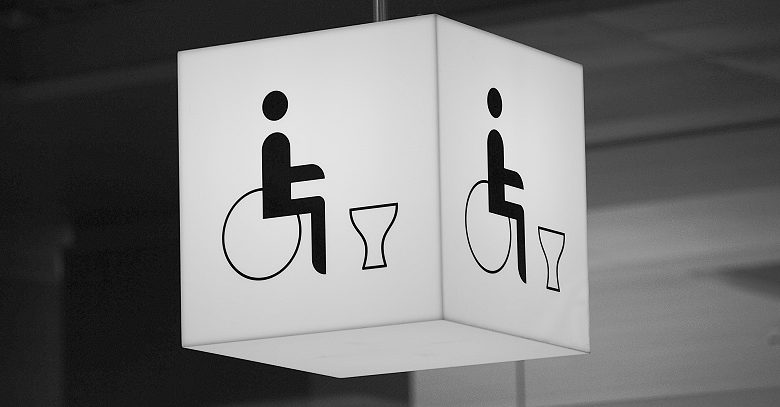
Samantha Renke shares her experiences with accessible toilets
We all have a number of toilet tales to tell. Stories of inaccessible loos, having to use unorthodox methods to go and toileting in front of strangers when there has been no other choice. Disabled actress, disability campaigner and AccessAble champion Samantha Renke is no different.
Here, she shares her stories, highlighting exactly why accessible toilets are vital for people with a range of disabilities, and what AccessAble is doing to help disabled people pee with dignity.
My name is Samantha Renke and I am an actress, activist and all-round loud northern bird currently living in central London. I was born with a rare genetic condition Osteogenesis Imperfecta, or more commonly known as Brittle Bones. I’ve never known life without a wheelchair.

Toilet tales if you’re disabled
Lots of us disabled folk have a strange and complex relationship with going to the loo. I’ve lost track of how many inanimate objects I’ve had to use as a ‘toilet’.
I often joke that people shouldn’t have a cup of tea when they come to my home because, chances are, I may have peed in the mug they are about to drink from. I’d like to note that it is never a result of coming home drunk, but pure desperation.
It happens when I end up fracturing a bone in bed, a common occurrence when living with Brittle Bones. It’s meant that the empty coffee mug on my bedside table has, at times, been the only way to relieve myself until an ambulance or my PA comes to assist me. I’ve subsequently invested in a slimline bedpan that I tuck away behind my pillow every night.
But this is one of many stories I have to tell about going to the loo. There was that family holiday to France when my mother decided that a hovercraft was the mode of transportation we were going to use to cross the channel.
The trouble was that the toilets were up a flight of stairs and the water was so choppy that I couldn’t safely be carried up to them. So, I found a cup, wrapped my jumper around my waist and went to the loo right there and then in front of passengers. It was my only option.
On another trip to America, when we couldn’t find an accessible toilet, my mother squeezed us both into a standard stall. The lack of room meant that she accidentally fractured my arm on the toilet roll dispenser.
These are just some of my stories. But I suspect we’ve all seen the ‘accessible loo’ being used as a storage cupboard, or the non-disabled couple wanting to use it as their own personal love shack, or that teenager who wants to use it as a changing and make-up room.
On flights, I’ve finally given in and invested in business class so that I can use my she-wee from my private seat – we all know that aircraft toilets aren’t accessible to many disabled people. I could go on….
Read our post about The Buckingham Foldeasy – the best portable toilet frame on the market
Accessible toilets
Although looking back some of these incidents are humorous, at the time they were traumatic, dangerous and downright degrading, so much so that I went through a phase of not going anywhere.
Like many of the 13.9 million disabled people living in the UK, I find accessing toilets that truly meet my access needs is a daily struggle. This can ultimately impact our well-being, mental health and independence.
AccessAble is working to end toilet anxiety. On the AccessAble website or app, you’ll find accessibility information for more than 16,000 accessible toilets.
As well as being able to find information on toilet when looking at places and buildings across the UK, it has a dedicated toilet section with more than 200 pieces of information just about loos. That’s right, 200! It includes location and access details, features, dimensions, fixtures, colour contrast, lighting, and baby changing facilities.
Watch AccessAble’s short video to see for yourself.
Charities are also fighting our corner. This includes the Changing Places campaign, which, over the last few years, has highlighted this long-standing frustration to the non-disabled community. It’s done the trick – people have been horrified about the idea of people laying on public bathroom floors or wetting themselves on trains.
Toilets for all disabled people
It’s important to remember that the fight for accessible toilets is not just about wheelchair users. Out of the 13.9 million people in the UK living with an impairment, less than 8% are wheelchair users.
Many impairments are in fact invisible, such as Crohn’s disease, colitis or multiple sclerosis, to name a few. People with these conditions also benefit greatly from being able to use accessible bathrooms.
Lest we also forget those who are autistic or have Asperger’s Syndrome, who have expressed that using public bathrooms can be incredibly overwhelming. Accessible bathrooms, on the other hand, filter out the noise and are much more user-friendly.
With invisible impairments in mind, many facilities across the UK have rolled out new bathroom signs to replace the iconic ‘wheelchair’ symbol for a universal ‘not every disability is visible’ and changed the phrasing from ‘disabled toilet’ to ‘accessible toilet’.
We may not want to talk about our bodily functions, but it’s actually one of the things we all have in common, disabled or not. Therefore, surely everyone has the right to be able to go anywhere and at any time – with dignity.
Don’t forget to download the free AccessAble app from the Apple store or Google Play store. The app has Detailed Access Guides to more than 70,000 venues across the UK, including more than 16,000 accessible toilets. Giving you factual, reliable accessibility information in your pocket to use on the go.
By Samantha Renke for AccessAble
Sam has designed a unique and stylish handbag (with disabled people in mind) that is available on our shop. You can also pick up a RADAR key to access 9,000 disabled toilets nationwide.
More on Disability Horizons…